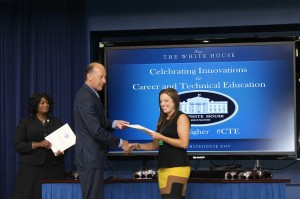Last week, New America held The Great Skills Race: Innovations in U.S. Education and Training from a Global Perspective to discuss what the skills gap looks like abroad and in the United States, and how it impacts employers, students, policy, the education system and more. Simon Field, Project Leader, OECD, started off the event by discussing what some big global trends are emerging around developing employees with the skills they need in both developed and emerging countries.
He explained that there is a global disillusion with the college for all concept, and that though it remains politically popular, increasingly studies show that it does not yield career-ready employees. For example, 70 percent of Koreans attend college, but this includes two-year programs to become a barista, and similar lower-skilled positions, where after two years students may not have very marketable or essential skills.
On the other hand, countries are ramping up their efforts to provide students with high-quality academic and work-based skills such as Indonesia, which is making a concerted effort to expand Career Technical Education (CTE). Currently, about a fourth of the population takes part in some CTE, and the country has a goal of expanding this number to 90 percent through a massive growth of CTE high schools.
Countries need to focus on education that bridges the gap between the world of learning and the world of work through strengthening employer engagement, educating the teacher workforce and developing work-based learning opportunities through apprenticeships, internships and more.
The panel then turned to Holly Zanville, Strategy Director at the Lumina Foundation who spoke about the value of credentials in the Foundation’s work. At this time, there is no system for evaluating credentials or certificates, or a way for educators, students, employers and parents to determine how credentials and certificates connect to jobs. Lumina is developing a website to address these issues along with:
- Creating a national dialog around credentials and certificates
- Developing a translation platform to connect credentials
- Developing a prototype of a credential registry including the competencies, quality of the credential, cost and more
- Launching a new website (in two weeks) as a clearinghouse for credential information to help students understand the value of the credential, and employers understand how credentials and certificates may increase the skills of their employees.
Next, Todd Greene, Vice President of the Federal Reserve System of Atlanta explained that the Federal Reserves is involved in workforce development, something not typically addressed by the Reserves, due to the financial crisis. Greene took over 40 meetings with local communities including business leaders, employers and educators to see what workforce development looked like on the ground. Through this work, Greene found that there was a vast disconnect between these groups, and many did not have any type of meaningful relationship resulting in educators often teaching the wrong skills, and employers disengaged with the community and experiencing a skills gap with their employees.
Now, all 12 Federal Reserves are involved in workforce development, often using convening as a method to combat unemployment. One of these convenings included over 30 historically black colleges to help the Federal Reserves understand why Black unemployment is vastly higher regardless of education level compared to White unemployment.
Last on the panel was Byron Auguste, Managing Director of Opportunity@Work who attributed the skills gap to a variety of things. The first concept Auguste described is that the skills gap is a result of market failure; it’s not just the government or education systems that are failing, it is also the duty of employers and industry to help solve the skills gap problem. Also, the country has been highly disinvested in this work. All of the focus and spending has been centered on former higher education with very little investment in adult learning.
In addition to changes in policy, there needs to be a change in business practice. Instead of hiring on degrees, there needs to be a focus on hiring based on skills, whether gained through a degree, previous work, credentials, certificates, apprenticeships, internships or more.
To watch a video of this lively discussion visit New America’s website.
Katie Fitzgerald, Communications AssociateÂ





